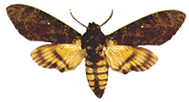|
Acherontia styx Westwood
Sphinx (Acherontia) styx Westwood, 1844, Cabinet Orient. Ent., p. 88.
Acherontia styx Westwood; Rothschild & Jordan, 1903: 21.
Acherontia medusa Butler, 1876, Trans. Zool. Soc. Lond., 9: 597.
|

Acherontia styx
(.65 natural size)
|
Diagnosis. See Acherontia lachesis
Fabricius.
Taxonomic notes. Bornean material is referable to ssp. medusa Butler.
Geographical range. Oriental Region to S. Moluccas.
Habitat preference. The species is very much rarer than its congener. In
recent surveys three specimens only have been taken, in a vegetable
growing area at Bundu Tuhan on G. Kinabalu (1200m).
Biology.
Dupont & Roepke (1941) stated the larva to be green or greyish brown
in Java, the horn less recurved than in lachesis. In India the green form
is much commoner than yellow or brown forms (Bell & Scott, 1937); the
thoracic segments are yellower than the rest, the coloration similar to
that of lachesis. In India the green form is much commoner than yellow or
brown forms (Bell & Scott, 1937); the thoracic segments are yellower
than the rest, the coloration similar to that of lachesis.
Recorded host-plants (Bell & Scott, 1937; Browne, 1968; Pholboon,
1965; Yunus & Ho, 1980; Miyata, 1983) are: Nerium (Apocynaceae);
Bignonia, Pyrostegia, Spathodea, Tecoma (Bignoniaceae); Porana
(Convolvulaceae);
Coccinia (Cucurbitaceae); Coleus (Labiatae); Dolichos, Erythrina, Glycine,
Psophocarpus, (Leguminosae); Eugenia, Syzygium (Myrtaceae); Jasminum,
Nycthanthes (Oleaceae); Sesamum (Pedaliaceae); Gardenia
(Rubiaceae);
Capsicum, Datura, Nicotiana, Physaliastrum, Solanum (Solanaccae);
Citharexylum, Clerodendrum, Tectona, Vitex (Verbenaceae).
<<Back
>>Forward <<Return
to Contents page
|

